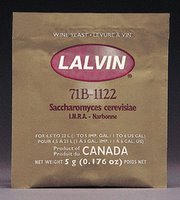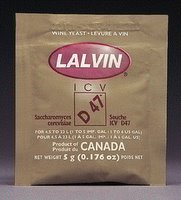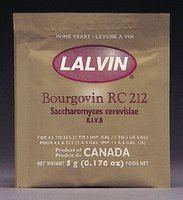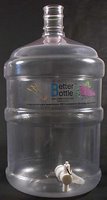As promised, here are the descriptions for Red Star Wine Yeast. I copied this information from the manufacturer's website Lesaffre Yeast Corp. I have used their products with a lot of success and it amazes me because I don't follow the instructions. I pitch the dry yeast in the must and let it go from there instead of rehydrating it. Seems to work well.

Product Description:
Red Star Premier Cuv© (Davis 796), a strain of Saccharomyces bayanus from a French wine yeast, is a special isolate of Red Star Yeast & Products. This yeast has good tolerance to ethanol and free sulfur dioxide, and ferments to dryness. Premier Cuv© is noted as a very low producer of foam, urea, and fusel oils. It is recommended for reds, whites and especially champagne. This yeast is reported to perform well restarting stuck fermentations. Winemakers have remarked that Premier Cuv© is the fastest, cleanest, and most neutral fermenter offered by Red Star®. Ferments best between 7°-35°C (45°-95°F).

Product Description:
Red Star® Pasteur Champagne (Davis 595), a strain of Saccharomyces bayanus, has been derived from a pure culture slant of the Institut Pasteur in Paris. This strain has been widely used in the U.S. since 1968. It is a strong fermenter with good ethanol tolerance, and will readily ferment grape musts and fruit juices to dryness. This strain also has good tolerance to free sulfur dioxide. This strain is recommended for all white wines, some reds and for fruit juices. Although this yeast is somewhat flocculant, it is not commonly used for sparkling wine. Pasteur Champagne has been recommended, by several sources, for restarting stuck fermentations. Ferments best between 15-30 deg. C, (59-86 deg. F).

Product Description:
Red Star® Pasteur RedTM (Davis 904), a strain of Saccharomyces cerevisiae, has been derived from the collection of the Institute Pasteur in Paris. It is a strong, even fermenter that produces full bodied reds. This yeast encourages the development of varietal fruit flavors, balanced by complex aromas, especially when using grapes of the Cabernet family. It may be necessary to cool the fermenting must to prevent unwanted temperature increase. This yeast is reported to give character to less robust red grapes, or those picked before optimum development.

Product Description:
Red Star® Cote des Blancs (Davis 750), a strain of Saccharomyces cerevisiae, has been derived from a selection of the Geisenheim Institute in Germany. It is a relatively slow fermenter, identical to Geisenheim Epernay, but producing less foam. This yeast requires nutrient addition for most chardonnay fermentations. Cote des Blancs produces fine, fruity aromas and may be controlled by lowering temperature to finish with some residual sugar. It is recommended for reds, whites, sparkling cuves and non-grape fruit wines (especially apple, it is reported). Ferments best between 17°-30°C (64°-86°F). Sensitive below 13°C (55°F).

Product Description:
Red Star® Montrachet (Davis 522), a strain of Saccharomyces cerevisiae, has been derived from the collection of the University of California. This strain has been widely used in the U.S. since 1963. It is a strong fermenter with good ethanol tolerance, and will readily ferment grape musts and fruit juices to dryness. This strain also has good tolerance to free sulfur dioxide. This strain is recommended for full bodied reds and whites. It is not recommended for grapes that have recently been dusted with sulfur, because of a tendency to produce hydrogen sulfide in the presence of higher concentrations of sulfur compounds. Montrachet is noted for low volatile acidity, good flavor complexity, and intense color.
Read more...

 Follow Me On Twitter
Follow Me On Twitter






















